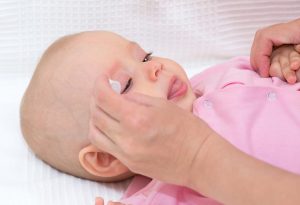In this Article
At times, your newborn baby could experience physical issues you were never prepared for. It could be worrisome to you and also cause discomfort to your little one. Although most issues can be taken care of, the ones affecting the most delicate parts of the body might put you in a difficult spot, for example, unusual discharge from your newborn’s eyes.
Your baby’s eyes are super delicate and frequent discharge from them can give rise to a lot of questions in your mind. Although it is common in many infants, understanding why and how it occurs will ease some of your worries and also help you address it better. This article should help you with all the information you need to know about eye discharge in newborn babies and ways to deal with it. But first, let’s check out some signs of eye discharge in a newborn baby.
Signs/ Symptoms of Eye Discharge in Newborn Babies
Eye discharge in newborn babies could indicate certain physical/health issues. It is, therefore, important to keep a close eye on the appearance of the eye discharge. If you see any of the following kinds of eye discharges in your newborn baby, you must take necessary actions immediately.
- Excessively watery eyes.
- Frequent pus formation.
- Sticky eyes with frequent pus that forms crusts on the eyelashes and the eyelids.
- Puffy eyelids.
- Yellow or green pus in the eyes.
- Red or pink eyes with sticky discharge.
What Are the Causes of Eye Discharge in Newborn Babies?
There might be many reasons for eye discharge in infants, and it could be something as simple as a common cold. Hence, it is important to find out what might be causing eye discharge in your baby. Some of these causes are listed below:
1. Eye Infection
A baby may have watery eyes, which is a sign of an eye infection. An infection may develop due to bacteria, fungi, or virus that your baby may have come in contact with. It can even occur when the baby comes in contact with a bacterium while passing through the birth canal. If your infant has redness or watery discharge and continues to rub his eyes frequently, it is a sign of an eye infection.
2. Blocked Tear Ducts
Around 10 percent of newborn babies have a condition called a blocked tear duct. In this condition, the baby has persistent watery eyes and the water does not drain properly. It leads to the accumulation of water in the tear ducts, which later runs down the cheeks even when the baby doesn’t cry. Some more symptoms of this condition include pus-like discharge and redness in the eye, particularly in the corner close to the nose.
3. Foreign Particle in the Eye
Particles of dust or dirt can get blown into your baby’s eyes leading to teary eye discharge. Your baby might blink constantly, and cry due to the pricking sensation caused by foreign particles.
4. Common Cold
Eye discharge in newborn babies could also be due to the common cold. As common cold is contagious, your baby might get it from the family members who have a cold. If a baby suffers from a common cold, it can lead to a blocked or runny nose and eye discharge.
5. Bacterial Conjunctivitis
Bacterial conjunctivitis is a highly contagious infection which could also lead to eye discharge that an infant may have contracted from you or your family members. Common symptoms of bacterial conjunctivitis are pus discharge from the eyes and sticky eyelids. This infection can occur in one or both the eyes.
By now, you are probably wondering if there is treatment available for eye discharge in newborn babies. In the next section of the article, we shall discuss some measures you can take at home and the treatment the paediatrician is most likely to give if the discharge is due to an infection. Read on to know more.
Treatment for Eye Discharge in Newborn Babies
If you notice any of the symptoms mentioned above in your newborn baby, you must not panic and take the necessary steps to treat them. Although it is recommended that you consult a paediatrician, you can tackle some cases at home. Let’s find out what you could do if your newborn has eye discharge.
1. Wipe Away any Discharge
As mentioned earlier, you can wipe away the discharge from around the eyes, especially when you notice persistent watery eyes in your baby. You may use a clean, soft, sterilized cloth/ towel to dab the water. If the discharge is sticky, you can use some warm water to soak the cloth/ towel and then gently wipe over and around your baby’s eyes.

2. Treating Blocked Tear Ducts
If your baby has a blocked tear duct, one of the ways you can help open them up is by gently massaging the inner lower corner of the baby’s eye, also known as the lacrimal sac. You can even massage your baby’s nose a couple of times or hold a warm compress over his eyes for 1-2 seconds a couple of times a day. If this doesn’t help, you must take him to a paediatrician.
3. Treatment for Bacterial or Viral Conjunctivitis
If your baby shows symptoms of conjunctivitis or pink eye, talk to your paediatrician immediately. He will prescribe an eye drop which should be administered as instructed. Keep an eye on your baby’s condition till his eyes get better and report any unusual discharge. To ensure that pink eye does not become a recurring issue in your infant, you may ask the paediatrician for an antiviral medication.
Your baby will not be able to express any discomfort he feels by using words, but there are signs that you can look out for to tackle eye discharge. To ensure the health of your baby’s eyes, it is important to watch out for these signs and treat them immediately.
References:









